According to one Global Startup Ecosystem Report, over 90% of startups fail completely.
One would usually assume that this is due to investors cutting off support. However, according to the CB Insights report The Top 20 Reasons Startups Fail, that’s only a problem 29% percent of the time, with a resounding 42% of startup failures caused by a lack of market need.
That means the greatest challenge for a scrappy startup is not a dwindling checkbook but instead maintaining a commitment to building a product that no one wants. Even the most well-funded, innovative companies that represent the gold standard of product management can miss the mark.
So that begs the question, how do we build the right thing?
In this blog, we’ll explore how Atlassian continuously strives to build successful products using our own products and processes to inspire and empower you to bring your best ideas to life while avoiding common pitfalls.
Craft clear business goals
A key distinction between an invention for a hobby or passion project and developing a product for a company lies in the underlying motivation: when crafting a product for a company, the primary goal is to enhance the business’s success. As a product leader, engineer, or designer, you are building the product to grow the business.
At Atlassian, we utilize Goals in Jira. This feature allows leaders to take their primary business objectives and break them down into manageable subgoals.
These subgoals may be revenue goals, reliability goals, or usage goals, to name a few. Our product organization then divides these business goals into respective product strategies.
Think of product strategies as guides for what you will need to accomplish to get from where you are to where you want to be. These evaluations are updated every 6 to 9 months and are informed by customer feedback.
Our product organization then takes these strategies and parses them into bets. These bets are actionable decisions that align directly with the overall goal and offer more specific guidance.
An Atlassian example of crafting business goals:

Tune in to your customers
Atlassian sees customer feedback as the bloodstream of any product team. Too often, we hear of a C-level executive in the news who pushes their company to produce one of their own ideas, only for it to fail with consequences.
Instead, at Atlassian, product groups start from the ground up by talking to customers to craft real-world solutions. We ask our customers:
- “Why do you do what you do?”
- “How can we help improve your day-to-day?”
This doesn’t guarantee success every time, but it puts you on a better track to building products that meet customer needs.
Open doors for customer feedback
Receiving clear, actionable feedback is a process that should not be taken lightly. It takes more than dropping anonymous notes in a suggestion box.
By reading your customers’ feedback you will learn a lot about how they actually use your products. This will lead to you and your teams discovering use cases you most likely never envisioned.
Atlassian’s product teams use Jira Product Discovery, Slack, and Jira Service Management to open multiple feedback channels to get the most holistic responses possible. This allows us to keep a consistent pulse on how customers are using our products.
Through Jira Product Discovery, customers can easily share feedback regularly through the “share your thoughts” pop-up feature, which is received directly by the product team. On Slack, Atlassian customer representatives are always standing by to respond to any questions or concerns from users in sales, support, marketing, and beyond.
Then, we centralize all of this information into Jira Service Management so that we can take this input and make it actionable.



On a weekly basis, one of our product managers will read all of the feedback that arrives. We can follow up with our customers through Jira Service Management allowing them to offer additional context as well. We can find what confused them, blocked them, or simply didn’t work so that we can keep that in mind when we build new features.
For deeper problem-solving or for documenting highly specific use cases, our product managers will setup a Zoom call to get to the heart of the customer’s needs. When you take this approach with the right customers, the benefits are huge.
Let the feedback simmer
Time is of the essence when building products and engaging in the creative process. But it’s also important to sit with the feedback and revisit it with a fresh mind.
A low and slow approach to cooking brings out the best flavor. The same can be said for absorbing feedback. On Day 1, you may see one thing; on Day 10, you may see something else.
TIP
Customer feedback is not created equally. Only customers with specific characteristics will provide you with the best value you need to build the right thing, such as customers who are:
- Clear communicators
- In your target segment
- Feeling the pain strongly for the problem we are trying to solve
- Looking for new ways to solve this pain
- Not using a competitor
- Open to changing the way they work to solve the problem at hand
- Willing and excited to use a product in its very early stages, share feedback, and share both problems and solutions they observe
Shape then prioritize
By tuning into your customers you link pieces of evidence to an idea. Now comes the process of shaping and prioritizing your offering. At Atlassian, we collect, prioritize, and roadmap, using the following process.

Collect
First, collect a long list of ideas to bring your product to life, whether they’re logical or wildly creative. This is the no-wrong-answers portion. At Atlassian, we use Confluence Whiteboards, which offer real-time collaboration asynchronously. When you’re ready, sticky notes can be transferred into a Jira Product Discovery project or a Confluence page.
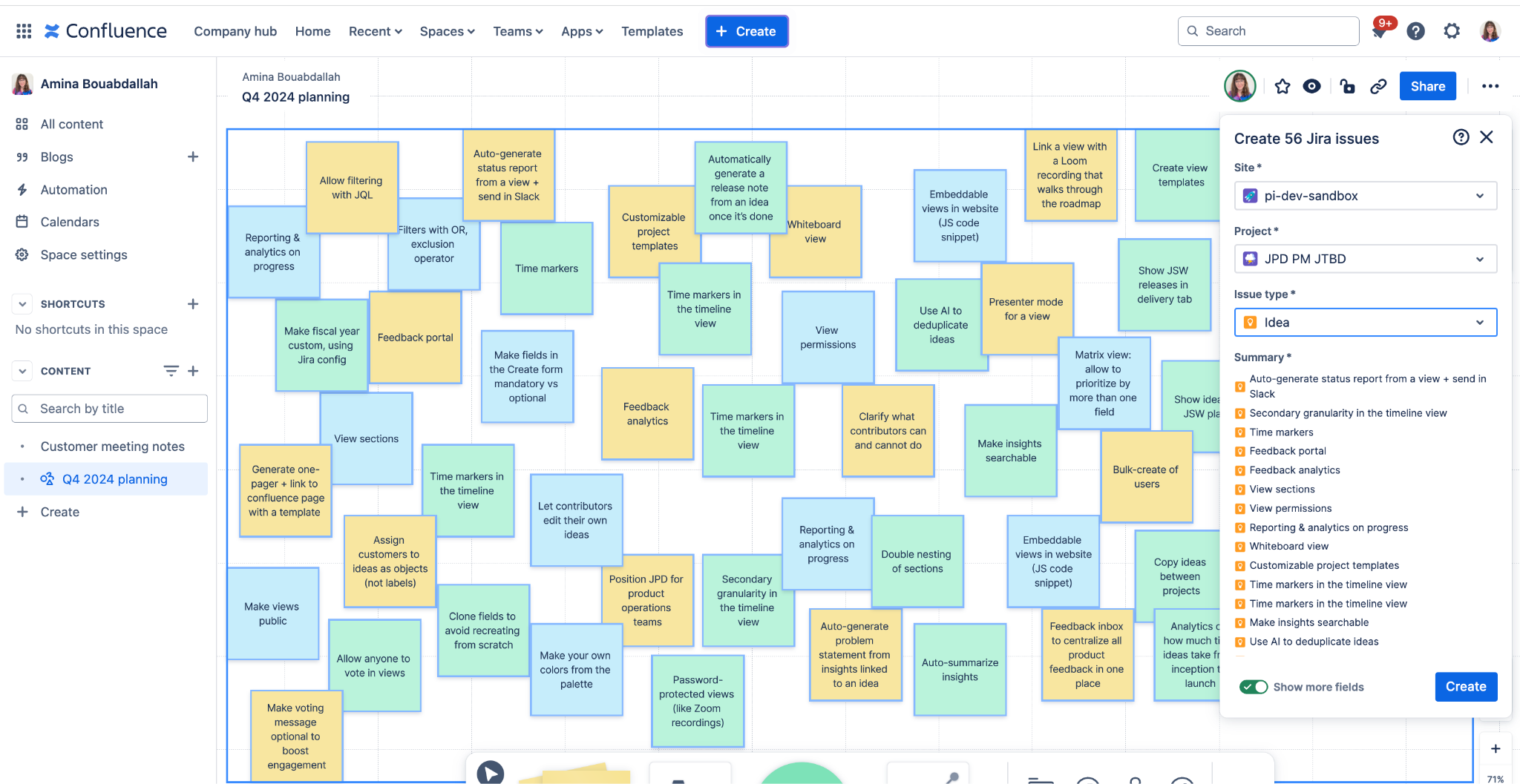
Prioritize
Now, it’s time to distill the long list by removing the unfeasible, undoable, or simply ridiculous ideas. This new list is your medium list, which is where you will prioritize and talk with your team about what to start with. Depending on your company context, you will need to figure out what you need to optimize for at that particular moment.
At Atlassian, we use Jira Product Discovery to filter our medium list and link the results back to our initial business goals and their bets. Within Jira Product Discovery, we can group ideas by segment while cross-referencing them with insights to assess the impact of customer demand on the segment we’re trying to work with.
By using Jira Product Discovery while maintaining a clear line of communication with customer-facing teams, we can filter, rank, and tie-break ideas so that it is easier to differentiate between medium and high-impact ones. It’s crucial for product managers to continuously engage with these customer-facing teams, not just to close deals on the products, but to maintain partnerships to keep us in the loop with their honest feedback.
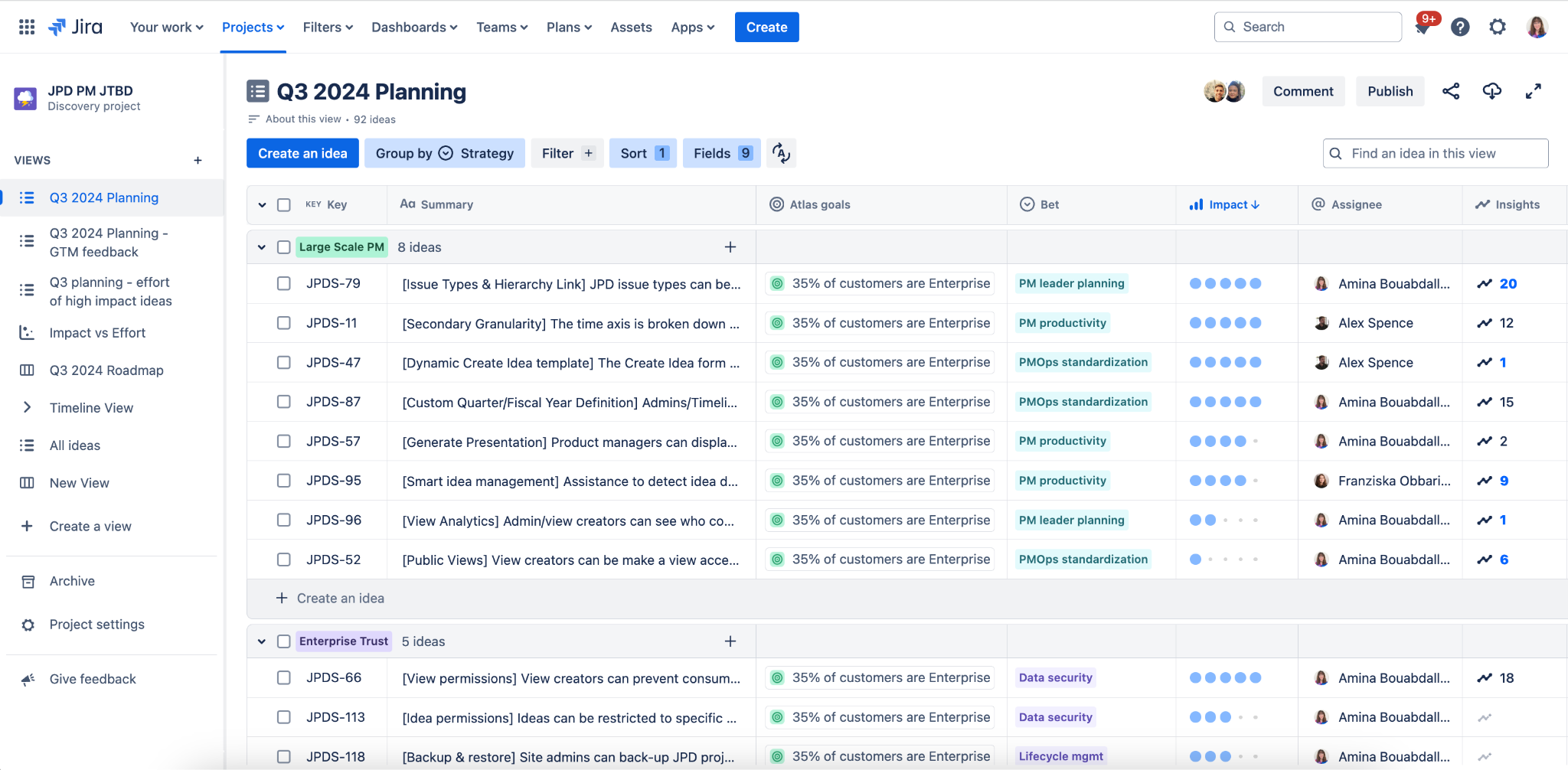
With Jira Product Discovery, Atlassian uses specific project views for sales reps and engineers, respectively. This gives them a voice and allows the ideas to be listed differently so the view doesn’t become overwhelming. More importantly, we give them the ability to manage ideas through the voting function in Jira Product Discovery.
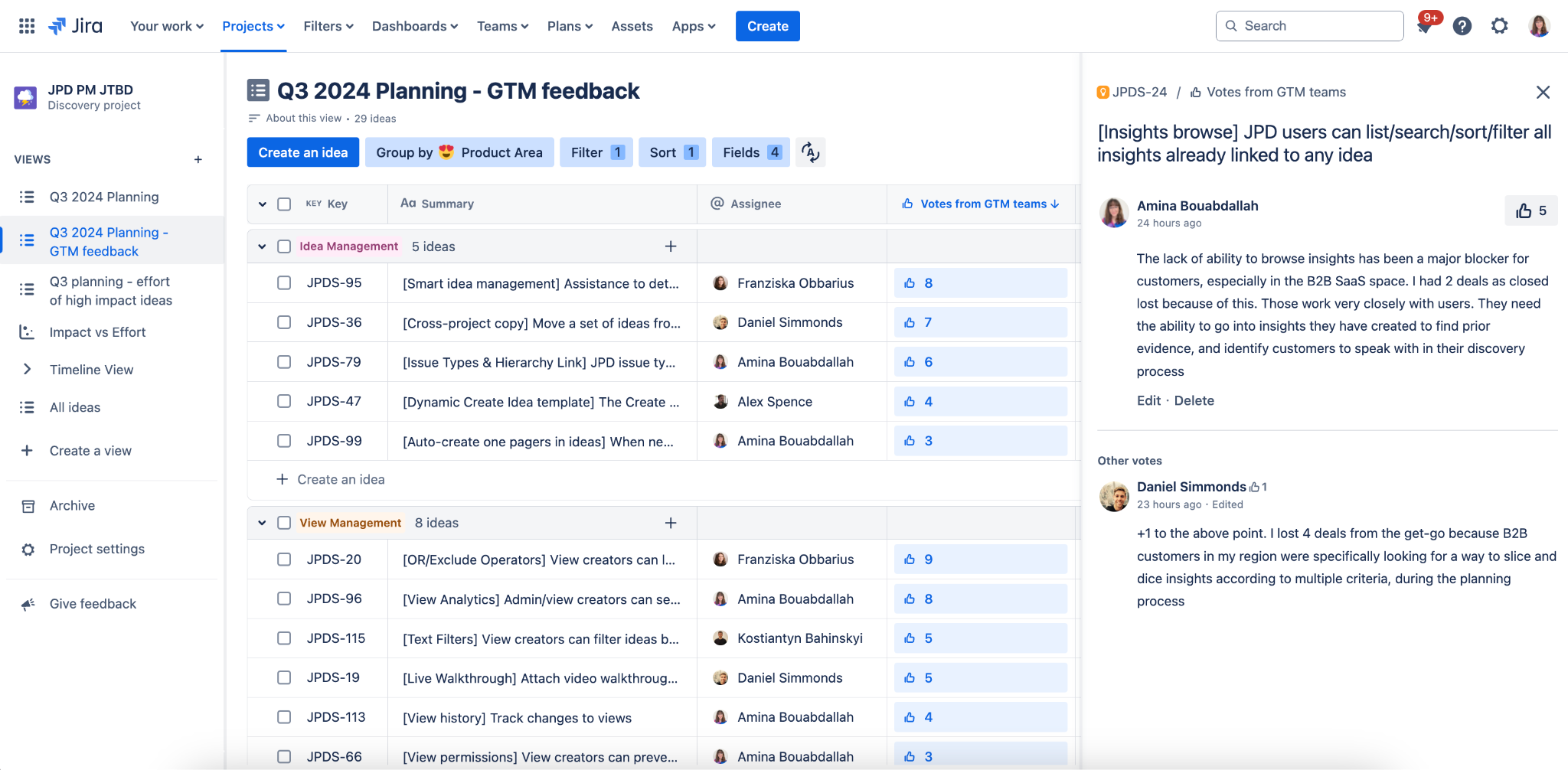
This keeps teams like engineering engaged from Day 1, not down the line when it’s time for them to execute. Assessing feasibility with your engineers early on helps ensure that you can build the right thing.
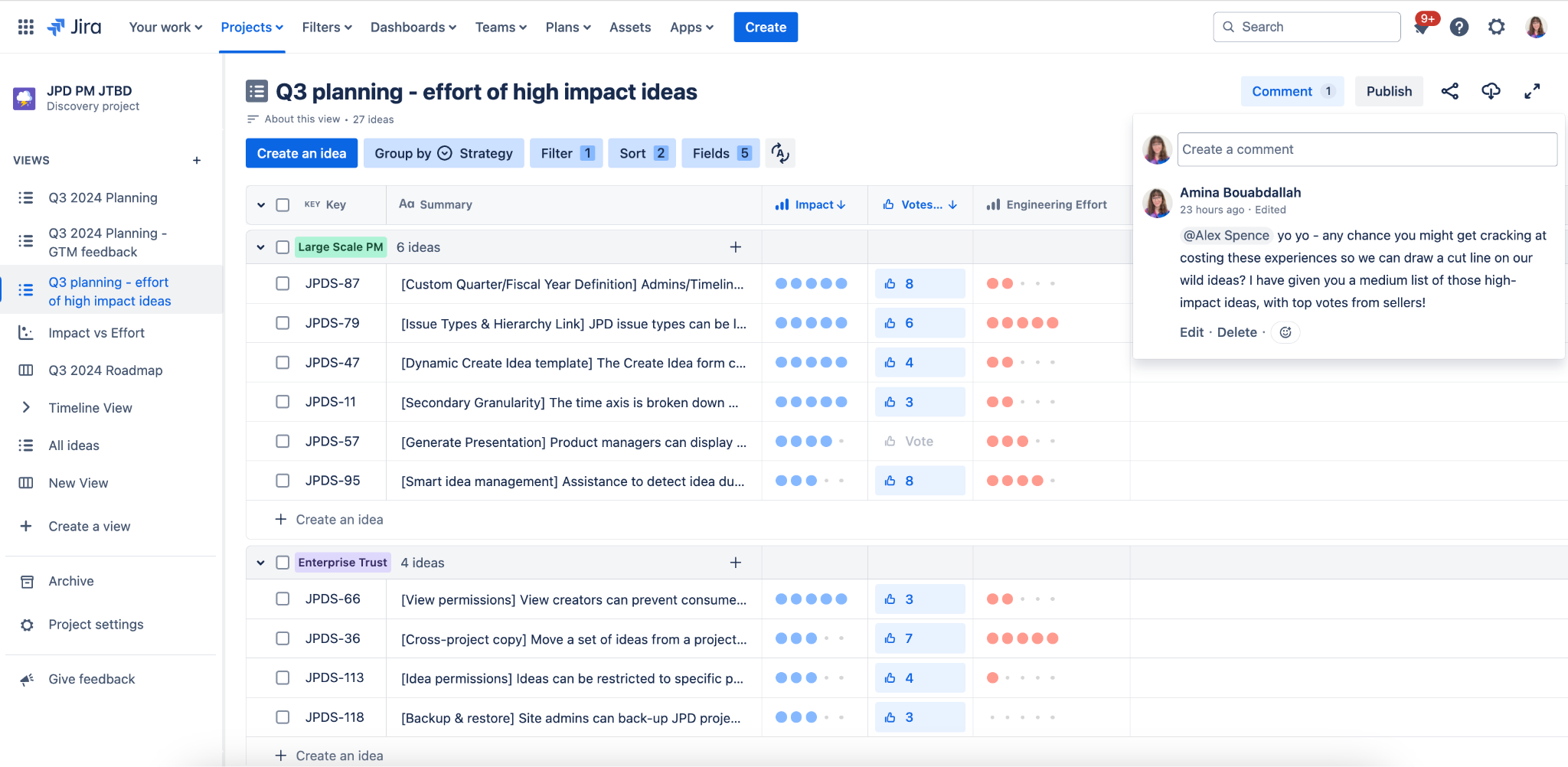
Weigh impact vs. effort
This is where the heaviest conversation about prioritization arises. It’s what determines whether you’re going to end up building the right thing or the wrong thing.
To handle this at Atlassian, we pull up a new view called impact vs. effort, which is a matrix with “impact” on the X-axis and “effort” on the Y–axis.

This means that the high-impact, low-effort ideas are in the top right corner of the matrix. These ideas are the “no-brainers” or “low-hanging fruits” that should be handled first.
At the bottom right of the matrix lie the high-impact, high-effort ideas, which we call “force multipliers.” These capabilities or ideas will dramatically move the needle for your business but will be hard to accomplish.
Now, don’t underestimate the medium-impact efforts. Accomplishing these can elevate user-friendliness and improve your relationship with your customers. At Atlassian, we call these “delighters”—these most likely won’t change the face of your business, but they will offer that je ne sais quoi.
Obviously, the low-impact ideas should be avoided, but balancing the medium-impact ideas with the high-impact ideas is the key to success. At Atlassian, we review and handle an easy-to-accomplish yet strategic amount of medium-impact ideas on a quarterly basis to make sure we don’t wear out the bandwidth of our teams while also consistently attending to our customers’ needs.
Roadmap: tell your story
Once we’ve identified the ideas to handle during the next quarter, it’s time to tell the story in the roadmap. Different product teams across Atlassian use different roadmap layouts in Jira Product Discovery, but for example’s sake, we’ll take a look at the 3×3 grid below.
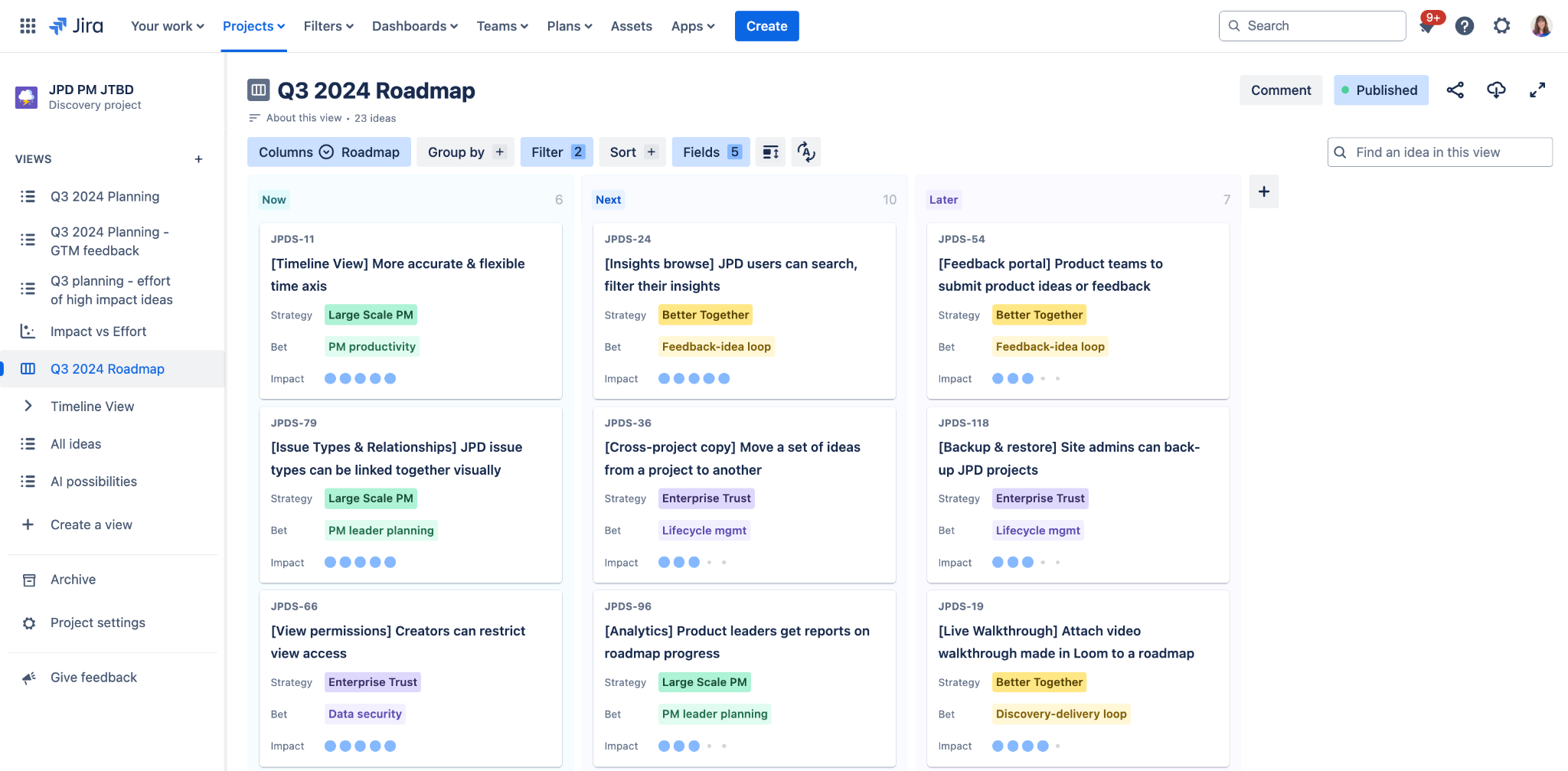
For this scenario, we have such simplified columns to work with because, by this point in the process, we are highly confident that this is the right thing to invest in right now according to the business goal we are trying to hit and the product strategy that was devised as a group.
At Atlassian, once we feel confident about our roadmap, we record a Loom to collaborate with our senior leaders and get buy-in. Due to the global nature of Atlassian, asynchronous communication is key to expediting collaboration, and Loom handles this perfectly.
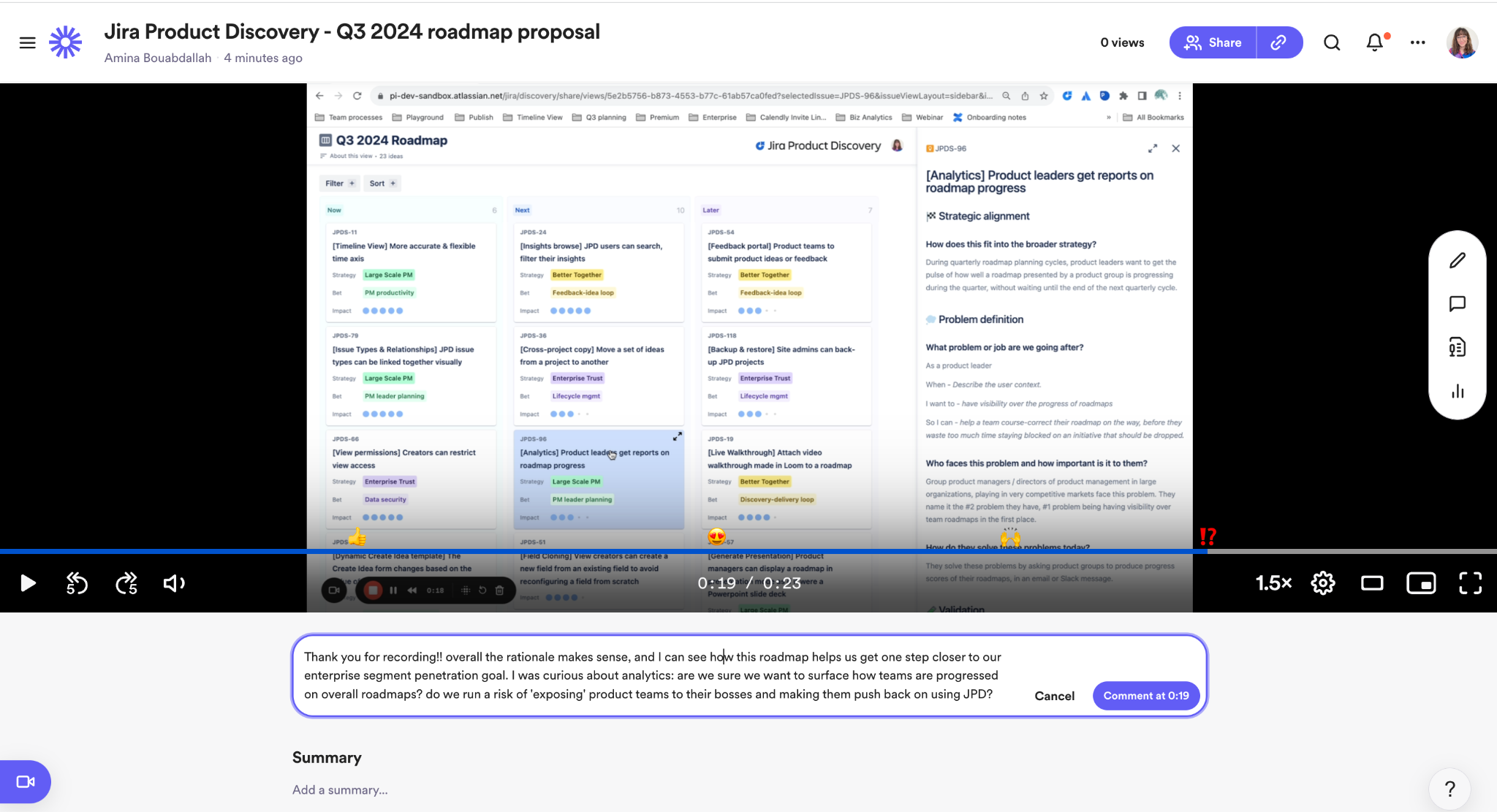
When we record our Loom presentations, we give a walkthrough in video format while the audience reviews the roadmap. Loom also allows comments to respond to specific time points in the video to allow for clear, mindful responses. If the comment is easy to respond to, a response can be directly addressed within Loom, but if it requires deeper communication, our product managers will setup a Zoom call with leadership.
Build the thing
Now, it’s time to get to work building the right thing. At Atlassian, we write product requirements documents (PRDs, also known as one-pagers or specs) for each idea in the roadmap.
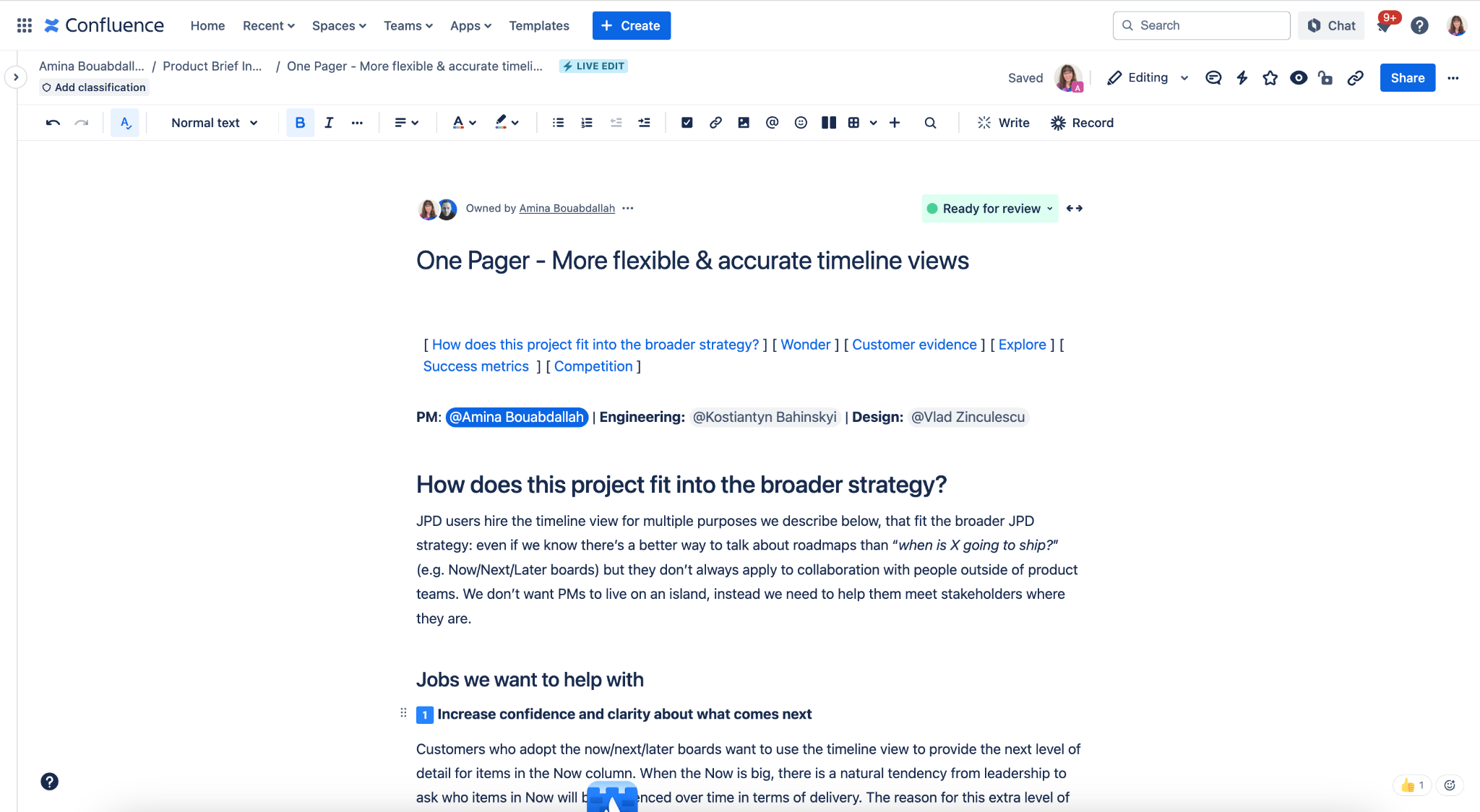
These PRDs are written by product managers and provide clear, detailed descriptions of vision, features, and scope. The more detailed behaviors of specific features are depicted within Figma.
The PRD is meant to:
- Align everyone, including product managers, engineers, designers, and stakeholders, on what is being built and why—without this clarity, teams may build features that don’t meet the needs of the business or user.
- Prevent scope creep by drawing boundaries of what should be built, and as a result, what should not be built
- Improve team efficiency through written requirements to minimize misunderstandings, reducing the need for rework, and the need to meet to double-check tasks.
Keep ideas neat and tidy
Once PRDs are drafted and added to the roadmap, we can visualize what will happen next, what tasks need to be completed later, and what tasks we will not complete.
We also have a record of everyone who requested improvements, allowing us to keep them up to date and receive feedback along the way. If they don’t respond positively or don’t respond at all, we can go back to the drawing board and reiterate our strategy.
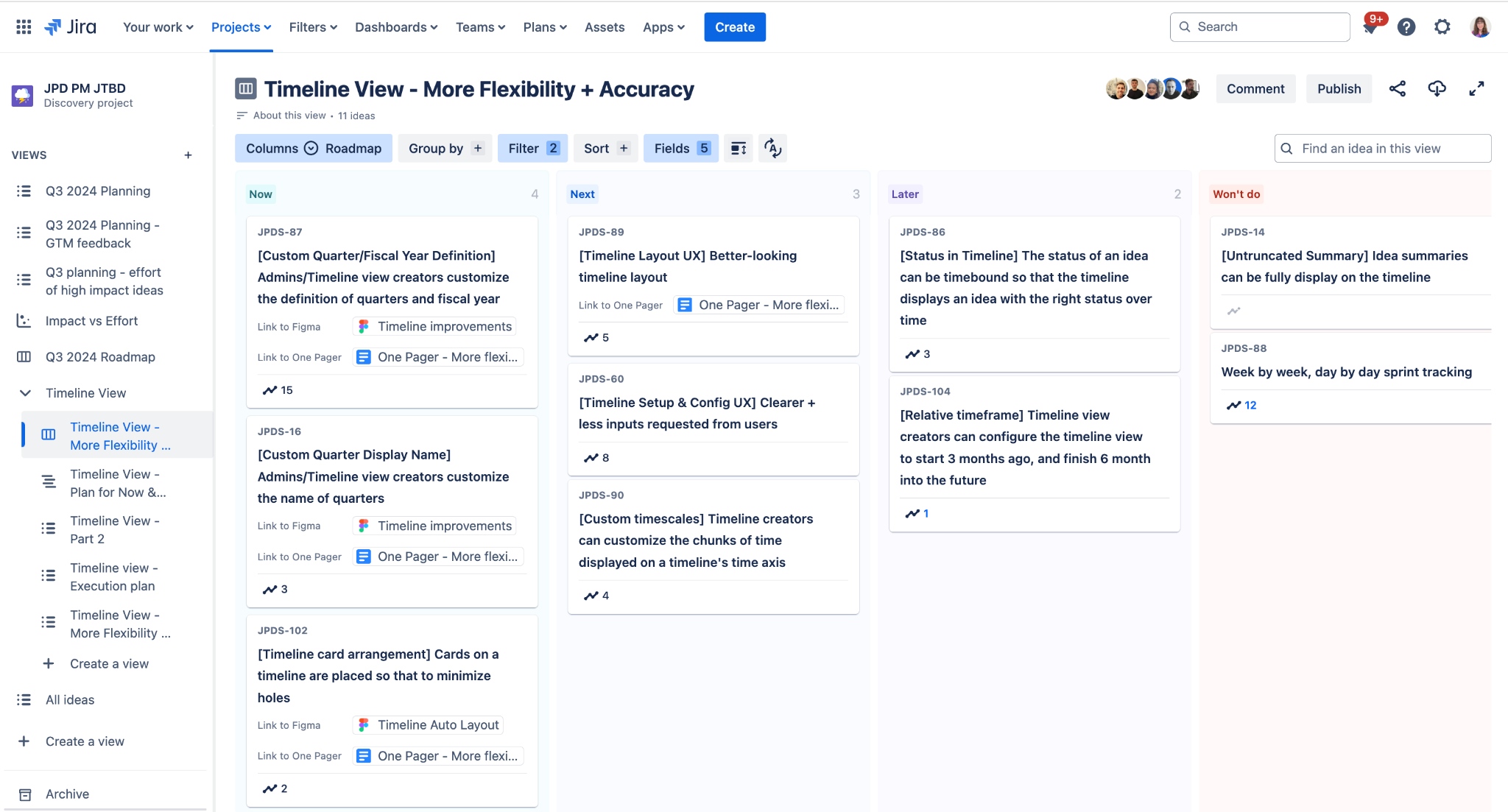
This provides teams with a high-level yet actionable view of work that can be embedded in a PRD Confluence page, linked with Figma, or bookmarked in a Slack channel.
Where engineering kicks off
Once there’s a clear plan and roadmap, it’s time to start writing code.
In the example below, we have a scenario of needing to implement user management at scale based on feedback from customers who are administrators who have difficulties setting up our products.

In this case, our engineering teams have built a delivery backlog of epics, tasks, and stories to list all of the work they need to accomplish. They then are able to link it to the corresponding idea on the Jira Product Discovery side to allow for full visibility across stakeholders without having to constantly distract our engineers with status update requests.
Engineers also gain full visibility into how their actions will impact the overall goals, which allows them to feel more involved in the process.
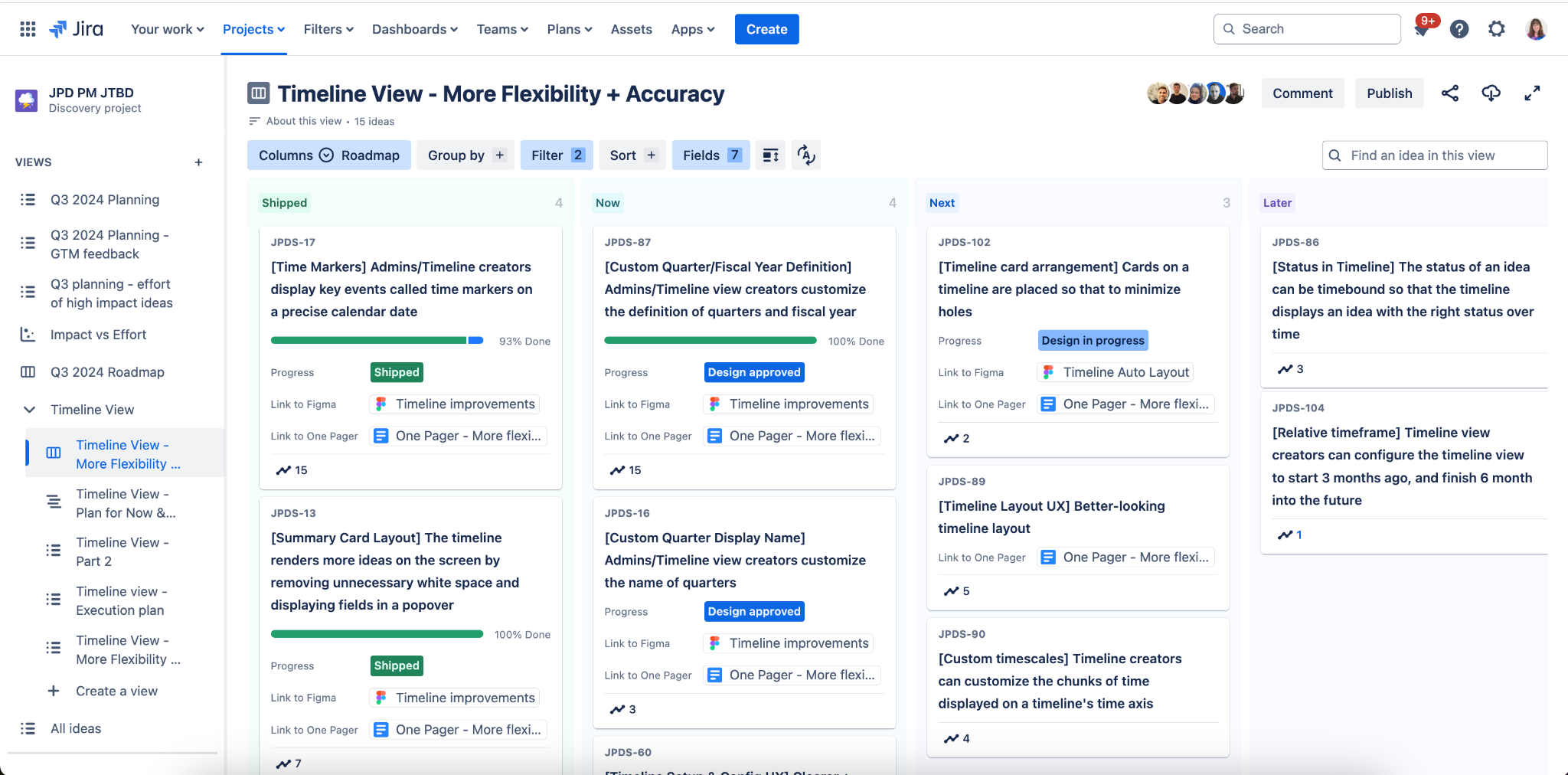
In this scenario, we can follow real-time status updates on what has shipped and what is in development. The actions toward the right side of the view are less defined at the moment; however, we make sure to keep them visible instead of discarding them.
In this case, our product team will meet every week and do demos. We make sure our product team is the first beta testers of our products and features well before any customers. This helps us validate and ensure that the product is ready for the public. If it doesn’t meet expectations, we go back to Figma and reiterate.
Close the loop
One very important activity Atlassian’s product organization engages in is “closing the loop.” After designs have been signed off on and engineering has written code, the product is launched to a small set of customers before gradually expanding the features.
Communicate releases
Customers who provided the initial feedback that inspired these projects will be the first to be notified of the launch and get early access. We record Looms to give them an accessible, in-depth overview of the new product or feature, helping them get up to speed faster.
This early access, alongside cultivated communication channels, allows us to receive more transparent feedback from customers who brought their initial problems or ideas to us while they use the product.
As we expand the offering, we will then take our Loom recording and share it in our community forums to educate our customers or in our team channels so that all Atlassians can learn how to use the latest product and continue building upon it.

Through Loom, we’re able to keep our users and potential customers up to date on the upgrades in quick bite-sized recordings.
Now, to avoid building the wrong thing, we also take a realistic look at the feedback we receive—if a feature or idea seems like it completely missed the mark, we don’t double down on it.
Communicate on goals
As features progress through their development, we keep our stakeholders informed on our progress using Goals. We do this by writing status updates linked to the corresponding goal letting them know we’ve tackled the most requested feature ideas with transparency on date—and hopefully zero support tickets on the topic.

By communicating this broadly we are able to share our statuses with senior leaders and generate energy about the work the product organization is doing. Building products can be like running a marathon, and this style of communication is like a recharging drink of water along the way.
In a nutshell
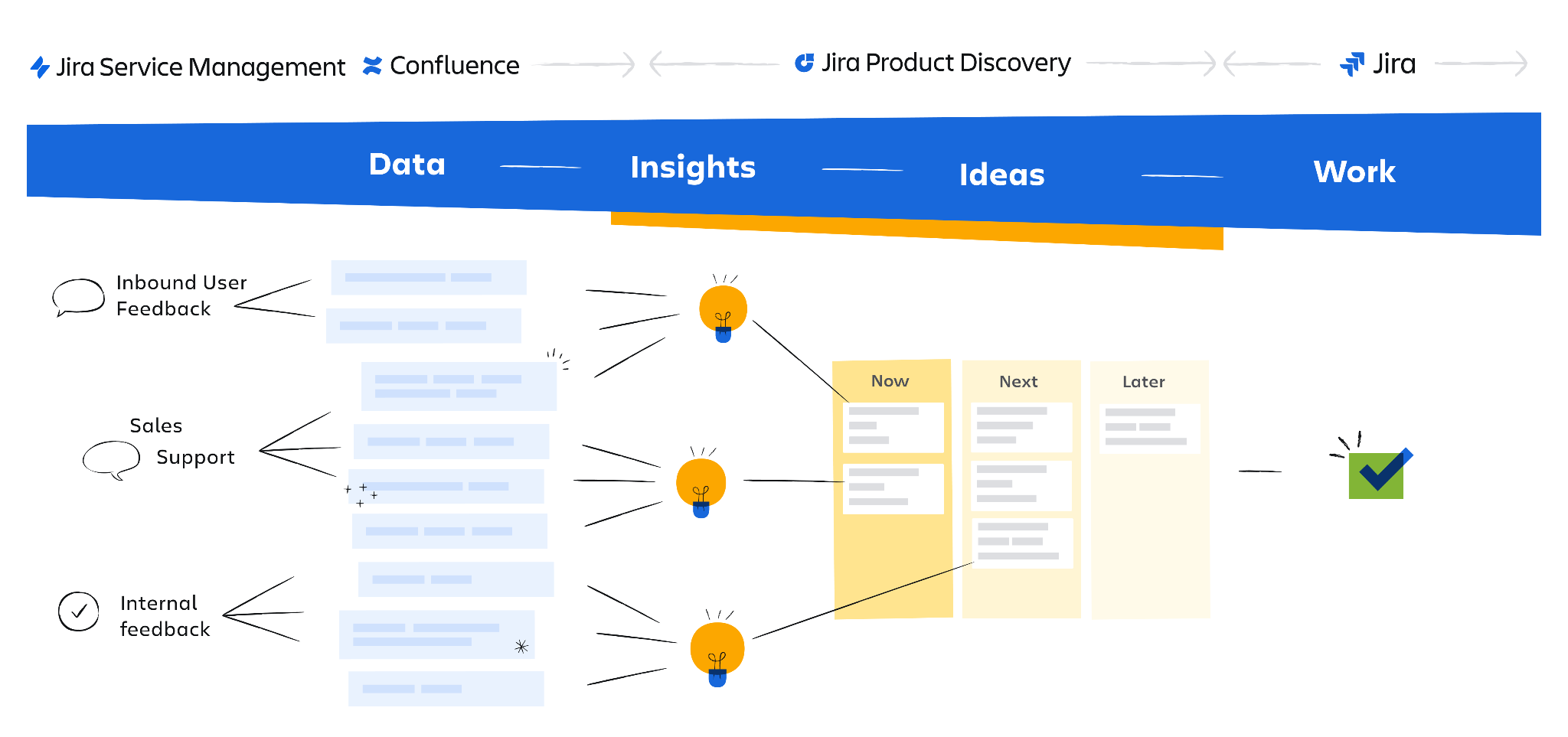
Building the right thing requires a clear process in coordination with the right tools to guide product discovery, development, and delivery. Atlassian works across our own suite to do our best to build the most useful products for our customers:
- Jira Service Management for receiving feedback
- Confluence for a deeper exploration of problems and for clarifying ideas through PRDs
- Jira Product Discovery for keeping track of the insights and product ideas to build roadmaps
- Jira for tracking engineering work connected to the roadmap in Jira Product Discovery
- Loom for communicating asynchronously with customers, team members, and stakeholders
That said, process and tools alone aren’t enough. During product development, you will encounter unexpected challenges, and new data will come to light. To truly build the right thing, teams need to embrace a culture that welcomes change, not as a failure but as a necessary step toward success.
Part of this culture is accepting that sometimes, what we plan might not be the right answer, and that’s okay. The moment we have evidence suggesting we’re building the wrong thing, we pivot and iterate, which can be when the magic of discovery happens.
Building the right thing takes courage to iterate, listen to the evidence, and ensure that every step forward is a step toward delivering true value.
